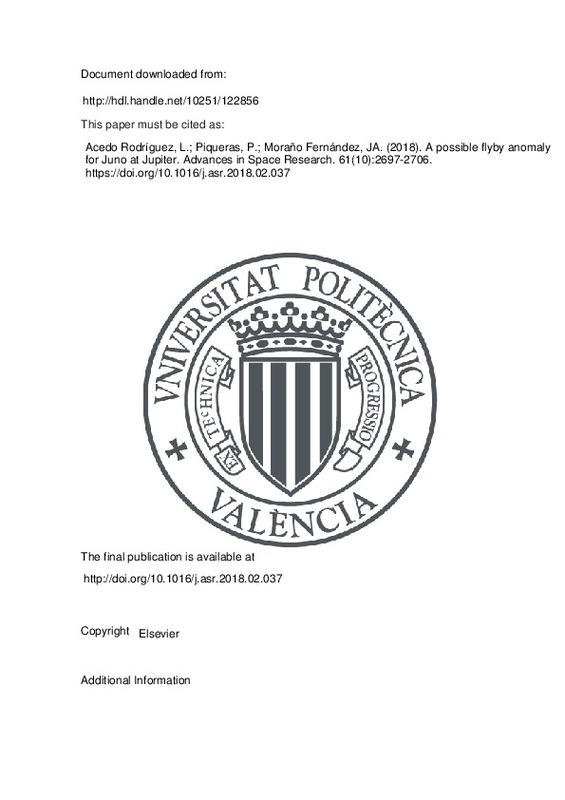JavaScript is disabled for your browser. Some features of this site may not work without it.
Buscar en RiuNet
Listar
Mi cuenta
Estadísticas
Ayuda RiuNet
Admin. UPV
A possible flyby anomaly for Juno at Jupiter
Mostrar el registro sencillo del ítem
Ficheros en el ítem
| dc.contributor.author | Acedo Rodríguez, Luis
|
es_ES |
| dc.contributor.author | Piqueras, P.
|
es_ES |
| dc.contributor.author | Moraño Fernández, José Antonio
|
es_ES |
| dc.date.accessioned | 2019-06-28T20:02:17Z | |
| dc.date.available | 2019-06-28T20:02:17Z | |
| dc.date.issued | 2018 | es_ES |
| dc.identifier.issn | 0273-1177 | es_ES |
| dc.identifier.uri | http://hdl.handle.net/10251/122856 | |
| dc.description.abstract | [EN] In the last decades there have been an increasing interest in improving the accuracy of spacecraft navigation and trajectory data. In the course of this plan some anomalies have been found that cannot, in principle, be explained in the context of the most accurate orbital models including all known effects from classical dynamics and general relativity. Of particular interest for its puzzling nature, and the lack of any accepted explanation for the moment, is the flyby anomaly discovered in some spacecraft flybys of the Earth over the course of twenty years. This anomaly manifest itself as the impossibility of matching the pre and post-encounter Doppler tracking and ranging data within a single orbit but, on the contrary, a difference of a few mm/s in the asymptotic velocities is required to perform the fitting. Nevertheless, no dedicated missions have been carried out to elucidate the origin of this phenomenon with the objective either of revising our understanding of gravity or to improve the accuracy of spacecraft Doppler tracking by revealing a conventional origin. With the occasion of the Juno mission arrival at Jupiter and the close flybys of this planet, that are currently been performed, we have developed an orbital model suited to the time window close to the perijove. This model shows that an anomalous acceleration of a few mm/s(2) is also present in this case. The chance for overlooked conventional or possible unconventional explanations is discussed. (C) 2018 COSPAR. Published by Elsevier Ltd. All rights reserved. | es_ES |
| dc.language | Inglés | es_ES |
| dc.publisher | Elsevier | es_ES |
| dc.relation.ispartof | Advances in Space Research | es_ES |
| dc.rights | Reconocimiento - No comercial - Sin obra derivada (by-nc-nd) | es_ES |
| dc.subject | Juno mission | es_ES |
| dc.subject | Tidal perturbations | es_ES |
| dc.subject | Jupiter's gravity model | es_ES |
| dc.subject | Flyby anomaly | es_ES |
| dc.subject.classification | MATEMATICA APLICADA | es_ES |
| dc.title | A possible flyby anomaly for Juno at Jupiter | es_ES |
| dc.type | Artículo | es_ES |
| dc.identifier.doi | 10.1016/j.asr.2018.02.037 | es_ES |
| dc.rights.accessRights | Abierto | es_ES |
| dc.contributor.affiliation | Universitat Politècnica de València. Departamento de Matemática Aplicada - Departament de Matemàtica Aplicada | es_ES |
| dc.description.bibliographicCitation | Acedo Rodríguez, L.; Piqueras, P.; Moraño Fernández, JA. (2018). A possible flyby anomaly for Juno at Jupiter. Advances in Space Research. 61(10):2697-2706. https://doi.org/10.1016/j.asr.2018.02.037 | es_ES |
| dc.description.accrualMethod | S | es_ES |
| dc.relation.publisherversion | http://doi.org/10.1016/j.asr.2018.02.037 | es_ES |
| dc.description.upvformatpinicio | 2697 | es_ES |
| dc.description.upvformatpfin | 2706 | es_ES |
| dc.type.version | info:eu-repo/semantics/publishedVersion | es_ES |
| dc.description.volume | 61 | es_ES |
| dc.description.issue | 10 | es_ES |
| dc.relation.pasarela | S\369617 | es_ES |







![[Cerrado]](/themes/UPV/images/candado.png)

